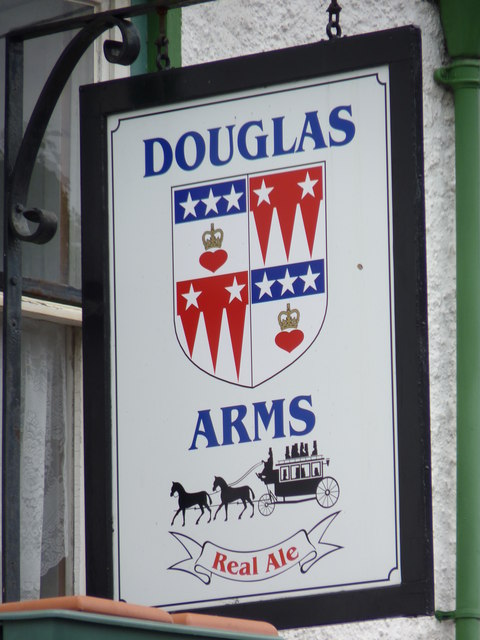Douglas Arms, Bethseda
 The
small town of Bethesda grew around the Penrhyn Slate Quarry, one of the largest
open cast quarries in the world. Further impetus was given to the village with
Telford's development of the A5 coach road between London and Holyhead, and the
construction of the famous suspension bridge over the Menai Strait. The
small town of Bethesda grew around the Penrhyn Slate Quarry, one of the largest
open cast quarries in the world. Further impetus was given to the village with
Telford's development of the A5 coach road between London and Holyhead, and the
construction of the famous suspension bridge over the Menai Strait.
The
Douglas Arms, a coaching inn with stables, a coach yard and accommodation for
the ostler, was probably built between 1810 and 1820. The life of the coach road
was short lived however, because by 1846 the railway had superceded the use of
stage coaches. The Davies family took over the inn in 1913. Phillip and
Elizabeth and their young son, Alfred took up residence and despite Phillip's
early death in 1915 remained here. Alfred married Marjorie in 1929, and they
continued running the business until Geoffrey and Sheila took over in the early
sixties and Gwyn and Christine arrived in 1997 to carry on the good work! Geoff
will be remembered by many for his obdurate resistance to decimalisation and we
will still quote you in pounds, shillings and pence if you like. (Ready reckoner:
one shilling = 5p, two shillings = 10p, half a crown = 12.5p, ten shillings =
50p, 240 old pennies to the pound.)
The landlord, Mr Henry Alfred Davies, writes to send a sketch of his
new sign, with a heraldic description of it for which he quite needlessly
apologises. (You need not trouble, Mr Davies, your heraldry is quite sound in
essence though it would probably distress Garter King at Arms.)
The arms
are those of the Hon. Edward Gordon Douglas, younger brother of the 16th Earl of
Morton, who married the co-heiress of the Penrhyn Estate in 1833, and who
subsequently took her name of Pennant in addition to his own, and induced the
Crown to revive in his favour the title of Baron Penrhyn which had become
extinct in 1808. They are nothing to do with the original Penrhyn family. They
are much older and more distinguished.
In the first and fourth quarters
they show argent a man's heart gules, ensigned with an imperial crown proper on
a chief azure three mullets of the field. In plain English this is a silver
shield with a blue band across the top and three silver stars on it, and on the
shield itself a red heart with a golden crown. These are the famous arms of
Douglas and date from the romantic episode in the fourteenth century which we
all have or ought to have learned about in our schooldays. The great Scottish
King, Robert Bruce, was never able to carry out personally the pledge he had
given to go and fight in Palestine for the recovery of the Holy Sepulchre. So on
his deathbed in 1329 he entrusted the duty to his bosom friend Sir James
Douglas.
Douglas set off in 1330, bearing with him the king's heart in a
golden casket. This he hoped to deposit in the Holy Sepulchre, but en route he
fell in battle in Spain - though still against the infidels. When he saw the day
was lost he hurled far into the ranks of the heathens the king's heart in its
golden case. Then he charged after it, and met his death as he wished, fighting
behind his king. The heart was recovered by Sir William Keith, who brought it
back to Scotland and buried it with the bones of Douglas in Melrose Abbey. Ever
since then the Douglases have borne on their shield the crowned heart.
It is a fine story, Mr Davies, and I am grateful to you for reminding me of it.
And it is interesting to find it commemorated not only, as one would expect, in
the state records of Scotland, and on the Douglas estates in Lanarkshire, but
also over a hotel in the heart of North Wales.
Article copied from The Technical Training News No 22 Dated 1950
See also:
Douglas heraldry
Any contributions will be
gratefully accepted
Errors and Omissions
|
|
The Forum
|
|
What's new?
|
|
We are looking for your help to improve the accuracy of The Douglas
Archives.
If you spot errors, or omissions, then
please do let us know
Contributions
Many articles are stubs which would benefit from re-writing.
Can you help?
Copyright
You are not authorized to add this page or any images from this page
to Ancestry.com (or its subsidiaries) or other fee-paying sites
without our express permission and then, if given, only by including
our copyright and a URL link to the web site.
|
|
If you have met a brick wall
with your research, then posting a notice in the Douglas Archives
Forum may be the answer. Or, it may help you find the answer!
You may also be able to help others answer their queries.
Visit the
Douglas Archives Forum.
2 Minute Survey
To provide feedback on the website, please take a couple of
minutes to complete our
survey.
|
|
We try to keep everyone up to date with new entries, via our
What's New section on the
home page.
We also use
the Community
Network to keep researchers abreast of developments in the
Douglas Archives.
Help with costs
Maintaining the three sections of the site has its costs. Any
contribution the defray them is very welcome
Donate
Newsletter
If you would like to receive a very occasional newsletter -
Sign up!
Temporarily withdrawn.
|
|
|
|
|
|
|
|
|


